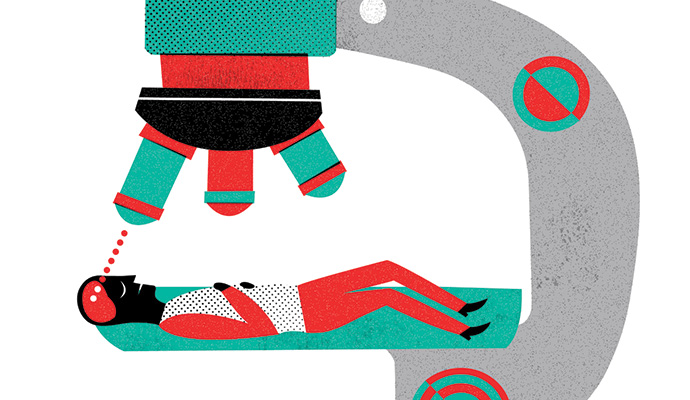Why your organization’s wellness app isn’t working
The pursuit of well-being shouldn’t feel like a rat race. Making three changes can help.
I recognized the buzz in my pocket. It was my daily reminder to meditate, courtesy of my employer’s wellness app. As usual, I ignored it and went back to work.
Make no mistake, I appreciate the concern and generosity reflected in my organization’s initiative. I have felt a persistent, disruptive stress during the pandemic. I’ve fully intended to develop a daily meditation practice. I know the benefits of doing so. And yet, the occasional nap after lunch is as close as I get.
Based on the reactions I get from others when I reveal my shortfall, I know I’m not alone. For many, stress was already a constant in their work lives before the pandemic. We feel the pain and know the remedy, yet we take no action. Why?
One explanation is our skewed sense of productivity. Many of us feel a pressing need to get more accomplished. But simply doing more isn’t actually productive unless we can do it in less time. We reason that meditating now just means email later. If we’re truly productive, though, we should be able to do both without putting in more hours. It’s the illusion of productivity that keeps us from prioritizing our well-being. And therein lies the paradox: wellness can boost productivity, but we’re all so busy being “productive” that we can’t find time for wellness.
Wellness can boost productivity, but we’re all so busy being ‘productive’ that we can’t find time for wellness.
A friend of mine told me about a manager at a large tech company who told him that she had great work–life balance because she left the office by 6 p.m. each day, made it home in time to eat dinner with her spouse, tucked her kids into bed—and she didn’t have to log back in to work until about 9 p.m. That’s balance? When I heard this anecdote, I also wondered if this manager really “had to” log back into work. Was it truly the workload or more of the cultural norm at the company? It’s true that if your team or organization spans time zones, emails and instant messages can ping at any hour. And if you work from home, the workday can seem infinitely elastic. Its call can be seductive: just a few more emails or entries on the kanban board and you’ll feel so productive!
It’s a trap. This view of productivity is based on transactions—and the transactions never end. We’re all trying to keep up with an accelerating conveyor belt of digital pings for our immediate attention. No wonder we collapse overwhelmed late into the evening.
Shannon Huffman Polson, author of The Grit Factor, former attack helicopter pilot, and current leadership coach, told me that she hears from her network a lot of glorification of the “eat it, sleep it, breathe it” approach to work. “It’s awful,” she said. “When your ‘on’ switch means 120% effort and your ‘off’ switch is almost never off, it’s simply unhealthy.”
Unhealthy, indeed. Recent World Health Organization (WHO) and International Labour Organization (ILO) research suggests that as many as 745,000 people died in 2016 from conditions linked to excessive work hours (more than 55 hours per week), up 29% from 2000. Stanford University’s Jeffrey Pfeffer, author of Dying for a Paycheck, told me, “Although the relationship between work hours and productivity is essentially null, companies and their leaders act as if the more someone works, the better and more productive they are. Until we measure behavioral and physical health and hold companies and their leaders responsible for those outcomes, nothing will change.”
To go deeper, I spoke with my Harvard colleague Dr. Brian Spisak, an evolutionary psychologist. He explained that his research suggests that for at least several decades, organizations have overselected for competitive ability in those who advance. From business school through the boardroom, prize-oriented individuals are recognized and rewarded. These highfliers thrive on the fight against rivals outside and inside the company. They dominate and drive change. They battle the clock. They push their bodies. They even try to out-meditate everyone else. These über–type A hyperachievers get a rush from winning, and they create organizational environments—“niche construction” in Spisak’s terms—where everything is an activity at which they must prevail. Maybe this is why a lot of organizations’ wellness programs feel more like contests, or just another set of boxes to check, than a way to slow down and truly practice self-care.
One CEO I worked with had what seemed to be a well-rounded lifestyle that included hard work along with exercise, healthy diet, meditation, and yoga. That is, it seemed healthy until you got a peek at their schedule: up at 4 a.m. to meditate, ready for the fitness trainer at 5, and at the office by 7 for an extended day of meetings and calls. Rinse and repeat. I was assessing the senior team at this CEO’s organization, and my report was that they were talented, committed, and exhausted. They simply could not keep up. And, as I predicted, several left the company.
So, what can leaders do about this productivity–wellness paradox? The following three moves can help.
Incorporate wellness outcomes into performance metrics. Pfeffer told me, “Prevention is more effective than remediation...so the best way to prevent ill health is to eliminate the practices that create it. We need to be concerned not just with economic outcomes but with health outcomes.” Polson echoed this when I talked with her, calling for putting health metrics for the team on every manager’s scorecard. Many large employers are measuring employee health. The next step is to tie manager evaluation to subordinates’ health and wellness. There are numerous obstacles, though, to doing this—including the potential for discrimination against people with chronic conditions and efforts to “game” the system. These should not be seen as insurmountable.
Think about wellness as a strategic opportunity. Sille Ostergaard, a former human resources leader who now coaches executives seeking balance in their lives, told me, “I help them reframe wellness and self-care as a strategic choice.” Ostergaard points out to them that burnout is financially and socially costly; the WHO study calls overwork “the risk factor with the largest occupational disease burden.” Then, she walks clients through a number of steps that tie achieving business goals to well-being. For instance, she helps them define their purpose, attune themselves to the effect of building relationships and resilience, set professional and personal boundaries, and understand self-care as a way of life rather than a goal. She told me, “It is about harmonizing what you can control and what you cannot in a way that makes it more likely that you will both achieve what you want and enjoy the journey.”
Emphasize collective responsibility. Perhaps the deepest shift that executives can make was revealed to me recently by a leader in a health system in the US. She said that in her organization, self-care was being shelved in favor of taking care of one another. This transfer of responsibility from the individual to the collective is important because social connection and support are key to resilience. The wellness journey is not one that any person should be expected to take alone.
In a time of rapid change and disruption, a leader’s pursuit of transactional efficiency is the fastest path to irrelevance because it crowds out necessary transformational thinking. A wellness app or program, no matter how well designed, simply adds to the transactional load unless it’s accompanied by a deeper shift in our mental model of work and life. Perceiving the faint signals of change on the horizon is far more valuable than clearing out an inbox. Busyness rarely results in breakthroughs. Leading calls for creating the conditions in which people thrive, not pushing them to exhaustion. The organizations best prepared for the uncertainty and turbulence ahead might be those that choose leaders who know how to slow down, connect deeply, and even switch off.






